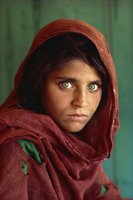Photojournalism as Art, Part 2
(To review Part 1, scroll down to Wednesday, February 15.)
Contemporary photography has continued the tradition of practitioners whose work serves journalistic and documentary purposes, and at the same time could be displayed as fine art in the most prestigious photo galleries. David Douglas Duncan made famous photographs of World War II and the wars in Korea and Vietnam. In much the same tradition, Donald McCullin gained notoriety for gritty black and white portrayals of wars in Cyprus, the Congo, Vietnam and Biafra. Steve McCurry, who works in color, has made photographs around the world, many of them on assignment for National Geographic magazine. He is the author of the iconic photograph Afghan Girl (right).
displayed as fine art in the most prestigious photo galleries. David Douglas Duncan made famous photographs of World War II and the wars in Korea and Vietnam. In much the same tradition, Donald McCullin gained notoriety for gritty black and white portrayals of wars in Cyprus, the Congo, Vietnam and Biafra. Steve McCurry, who works in color, has made photographs around the world, many of them on assignment for National Geographic magazine. He is the author of the iconic photograph Afghan Girl (right).
 displayed as fine art in the most prestigious photo galleries. David Douglas Duncan made famous photographs of World War II and the wars in Korea and Vietnam. In much the same tradition, Donald McCullin gained notoriety for gritty black and white portrayals of wars in Cyprus, the Congo, Vietnam and Biafra. Steve McCurry, who works in color, has made photographs around the world, many of them on assignment for National Geographic magazine. He is the author of the iconic photograph Afghan Girl (right).
displayed as fine art in the most prestigious photo galleries. David Douglas Duncan made famous photographs of World War II and the wars in Korea and Vietnam. In much the same tradition, Donald McCullin gained notoriety for gritty black and white portrayals of wars in Cyprus, the Congo, Vietnam and Biafra. Steve McCurry, who works in color, has made photographs around the world, many of them on assignment for National Geographic magazine. He is the author of the iconic photograph Afghan Girl (right).Sebastião Salgado is a Brazilian, educated in economics there and in Paris, whose work in Brazil and in England eventually took him to Africa as economist for an international coffee organization. At that time he began serious work in photography. Since then he has captured images of famine in Africa, manual labor in open-pit Brazilian mines, the migrations of peoples around the world, and a global effort to eradicate polio. His photography is entirely in black and white. During one seven-year period, he photographed in 39 countries. The example below, from 1984. shows refugees in Korem, Ethiopia.


James Nachtwey is perhaps the best-known of present day war photographers. He has documented conflicts in Latin America, Africa, Asia and the Middle East. The winner of many awards, Nachtwey was featured in the 2001 documentary film War Photographer. Many scenes in that film were captured with a small video camera mounted above the viewfinder of his still camera, giving the audience a photographer's-eye-view of Nachtwey's often dangerous work. The example below, however, runs almost contrary to type. The gauze of dust and the girls' colorful dresses create a beauty that contrasts their precarious situation in 1984 El Salvador.


Photographers such as Salgado and Nachtwey are often the subject of criticism from different, sometimes-contradictory, directions. When their photographs show intense suffering, even carnage, the photographers are accused of engaging in a kind of visual pornography, concentrating too much on the awful, sensationalistic cruelty that they exhibit. Yet when the photographs primarily show nuances of light and shadow, line and texture, the photographers are subject to criticism that the photos are too artsy, and that they make a kind of beauty out of horrors that should not be diluted. Certainly the photographs do show a wide spectrum of the human condition. The people who make the photographs are unusually able to be. simultaneously, skillful craftsmen, detached enough to do the mechanical work of making photos, and sensitive artists. Most of them are dedicated to making images that might help to bring about an end to the conditions they portray.
A very recent example of photojournalism that does not gloss over the harsh reality of war in Iraq is Unembedded. To create the resulting book and exhibition, four independent photojournalists and three filmmakers worked outside the auspices of the U.S. military. The project depicts the situation for fighters on both sides, as well as for the civilian population. Be aware that many of the photographs are quite graphic. The link to Unembedded is here.
Salgado is one of the photographers featured at the Masters of Photography site (in the list of links, above right). Links to the work of other contemporary photojournalists are here:

0 Comments:
Post a Comment
<< Home